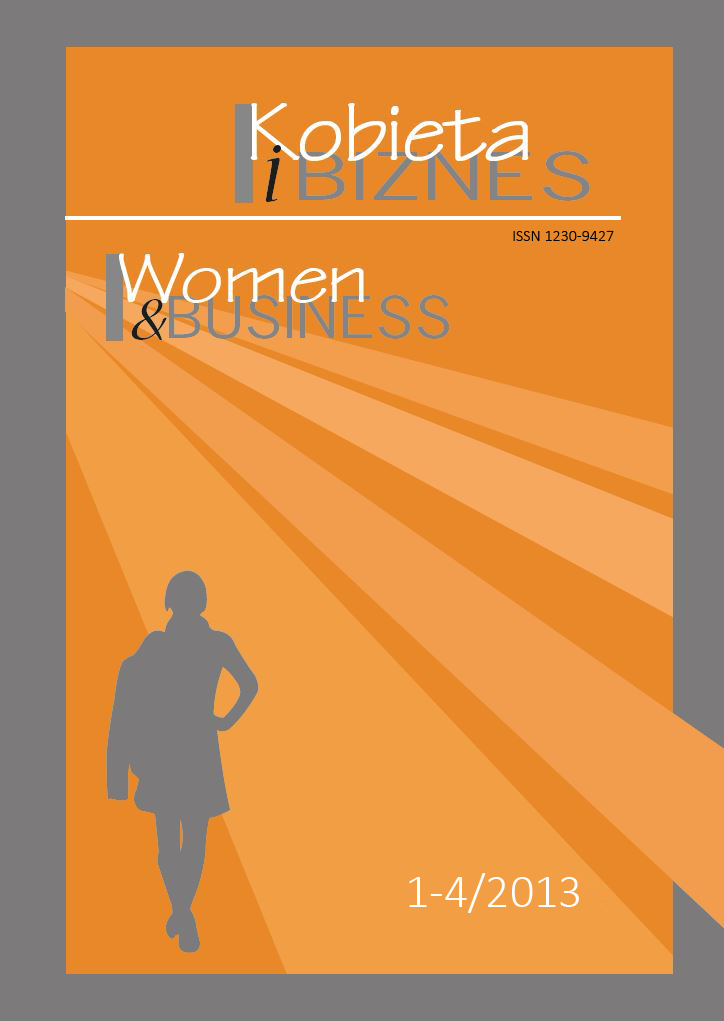Uwarunkowania przedsiębiorczości kobiet w Polsce związane z macierzyństwem
##plugins.themes.bootstrap3.article.main##
Abstrakt
Polska konstytucja zapewnia kobietom takie same prawa w zakresie prowadzenia własnej działalności gospodarczej jak mężczyznom. Jednak zjawiska o charakterze gospodarczym zachodzą w określonym kontekście społecznym i kulturowym, w którym funkcjonują kulturowe wzorce ról przypisanych płciom i różne oczekiwania społeczne wobec matek i ojców małych dzieci. W Polsce nadal dominują tradycyjne wzorce, według których to matka jest przede wszystkim odpowiedzialna za opiekę nad małym dzieckiem. W rezultacie więc podjęcie i prowadzenie działalności gospodarczej przez matki wiąże się z wyższymi kosztami niż w przypadku ojców. Do kosztów tych zaliczyć można m.in. koszty psychologiczne (związane z przeciwstawieniem się oczekiwaniom społecznym oraz z łączeniem ról/obowiązków zawodowych i rodzinnych), a także koszty związane z zapewnieniem zewnętrznej opieki nad małym dzieckiem oraz ubezpieczeniem chorobowym w celu uzyskania możliwości skorzystania z płatnego urlopu macierzyńskiego (koszty ekonomiczne). Istotne trudności związane są z załatwianiem spraw administracyjno-podatkowych przez przedsiębiorców w Polsce. W obliczu dysponowania przez matki mniejszą elastycznością oraz liczbą godzin, jakie mogą przeznaczyć na pracę zawodową, napotykają one na dodatkowe bariery w prowadzeniu własnej działalności gospodarczej w porównaniu do ojców.
##plugins.themes.bootstrap3.article.details##
Autor (Autorzy) artykułu oświadcza, że przesłane opracowanie nie narusza praw autorskich osób trzecich. Wyraża zgodę na poddanie artykułu procedurze recenzji oraz dokonanie zmian redakcyjnych. Przenosi nieodpłatnie na Oficynę Wydawniczą SGH autorskie prawa majątkowe do utworu na polach eksploatacji wymienionych w art. 50 Ustawy z dnia 4 lutego 1994 r. o prawie autorskim i prawach pokrewnych – pod warunkiem, że praca została zaakceptowana do publikacji i opublikowana.
Oficyna Wydawnicza SGH posiada autorskie prawa majątkowe do wszystkich treści czasopisma. Zamieszczenie tekstu artykuły w repozytorium, na stronie domowej autora lub na innej stronie jest dozwolone o ile nie wiąże się z pozyskiwaniem korzyści majątkowych, a tekst wyposażony będzie w informacje źródłowe (w tym również tytuł, rok, numer i adres internetowy czasopisma).
Osoby zainteresowane komercyjnym wykorzystaniem zawartości czasopisma proszone są o kontakt z Redakcją.
Autor zgadza się na dalsze udostępnianie pracy wg wymagań licencji CC-BY-NC
Bibliografia
ASM (2006), Diagnoza sytuacji kobiet na rynku pracy w Polsce. System aktywizacji zawodowej kobiet - "Kobieta Pracująca", ASM Centrum Badań i Analiz Rynku, Kutno.
Auleytner J. (red.), 2007, Wieloaspektowa diagnoza sytuacji kobiet na rynku pracy, SPO RZL 1.6(b). Raport Końcowy, Warszawa.
Del Boca D., Pasqua S., Pronzato C., 2009, Motherhood and market work decisions in institutional context: a European perspective, "Oxford Economic Papers", nr 61, p.47-171.
Del Boca D., Aaberge R., Colombino U., Ermisch J., Francesconi M., Pasqua S., Strom S., 2003, Labour market participation of women and fertility: the effect of social policies, Paper presented at the FRDB CHILD conference, Alghero, June.
Doing Business Report 2013, Smarter Regulations for Small and Medium Size Entreprises, World Bank.
Firlit-Fesnak G. (red.), 2008, Wykształcenie i kwalifikacje kobiet a ich sytuacja na rynku pracy, ASPRA-JR, Warszawa.
GUS, 2012, Aktywność ekonomiczna ludności Polski w I kwartale 2011 r., Warszawa.
GUS, 2013, Aktywność ekonomiczna ludności Polski I kwartał 2013, Warszawa.
Kantorowicz J., Żuk D., Wojciechowski W. (red.), 2008, Jak uwolnić przedsiębiorczość w Polsce?, Raport Forum Obywatelskiego Rozwoju, Warszawa.
Kotowska I. (red.), 2009, Strukturalne i kulturowe uwarunkowania aktywności zawodowej kobiet w Polsce, Warszawa, Wydawnictwo Scholar.
Kotowska I., Sztanderska U., Wóycicka I. (red.), 2007, Aktywność zawodowa i edukacyjna a obowiązki rodzinne w Polsce W świetle badań empirycznych, Scholar, Warszawa.
Kurowska A. (red.), Dwórznik I., Franczak P., 2011, Ekspertyza pt. Prawo sprzyjające przedsiębiorczości kobiet. Rekomendacje zmian, PARP, Warszawa.
Kurowska A., 2010a, Bariery i uwarunkowania aktywności ekonomicznej młodych matek w Polsce, "Polityka Społeczna", nr 11-12.
Kurowska A., 2010b, Jak możemy zwiększyć aktywność zawodową młodych matek w Polsce?, Raport Forum Obywatelskiego Rozwoju, Warszawa.
Kurowska A., Kocot-Górecka K., 2013, Znaczenie sytuacji rodzinnej, wzorców rodzinnych i postaw wobec kulturowych ról płci dla zatrudnienia matek małych dzieci w Polsce, "Studia Demograficzne" (w druku).
Leifbroer A.C., Corijn M., 1999, Who What Where and When? Specifying the Impact of Educational Attainment and Labour Force Participation on Family Formation, "European Journal of Population", nr 15: 45-75.
Lisowska E., 2001, Przedsiębiorczość kobiet w Europie Środkowo- Wschodniej, Oficyna Wydawnicza Szkoły Głównej Handlowej w Warszawie, Warszawa.
Matysiak A., 2011, On the interdependencies between fertility and women's labour supply, "European Studies of Population", nr 17.
Muszyńska M., 2007, Structural and Cultural Determinants of Fertility in Europe, Warsaw School of Economics, Warsaw.
NIK, 2008, Informacja o wynikach kontroli funkcjonowania przepisów i procedur dotyczących działalności gospodarczej (jako bariery dla rozwoju przedsiębiorczości), Warszawa.
OECD, 2010, OECD Family Database, dostępne na stronie: http://www.oecd.org/dataoecd.
PKPP Lewiatan, 2011, Czarna lista barier dla rozwoju przedsiębiorczości, PKPP Lewiatan, Warszawa.
Rolnik-Sadowska E., 2010, Przedsiębiorczość kobiet w Polsce, Wydawnictwo Difin, Warszawa.
Starczewska-Krzysztoszek M., 2008, Bariery rozwoju małych i średnich przedsiębiorstw w Polsce, Infos, nr 4(208), Biuro Analiz Sejmowych.
Słotwińska-Rosłanowska E., 2013, Raport z badania nr KAE/S/40/13 pt. Organizacja opieki nad dziećmi do lat 3 oraz w wieku 3-5 lat - dostępność i koszt opieki instytucjonalnej vs. preferencje i praktyki rodziców, Szkoła Główna Handlowa W Warszawie, Warszawa.
Słotwińska-Rosłanowska E., 2011, Raport z badania GGS-PL: Formy i koszty opieki nad dziećmi z gospodarstwach z minimum jednym dzieckiem do lat 14, niepublikowany raport z badań "Generacje, rodziny i płeć kulturowa - GGS-PL", nr 554/N-UNECE/2009/0 .

